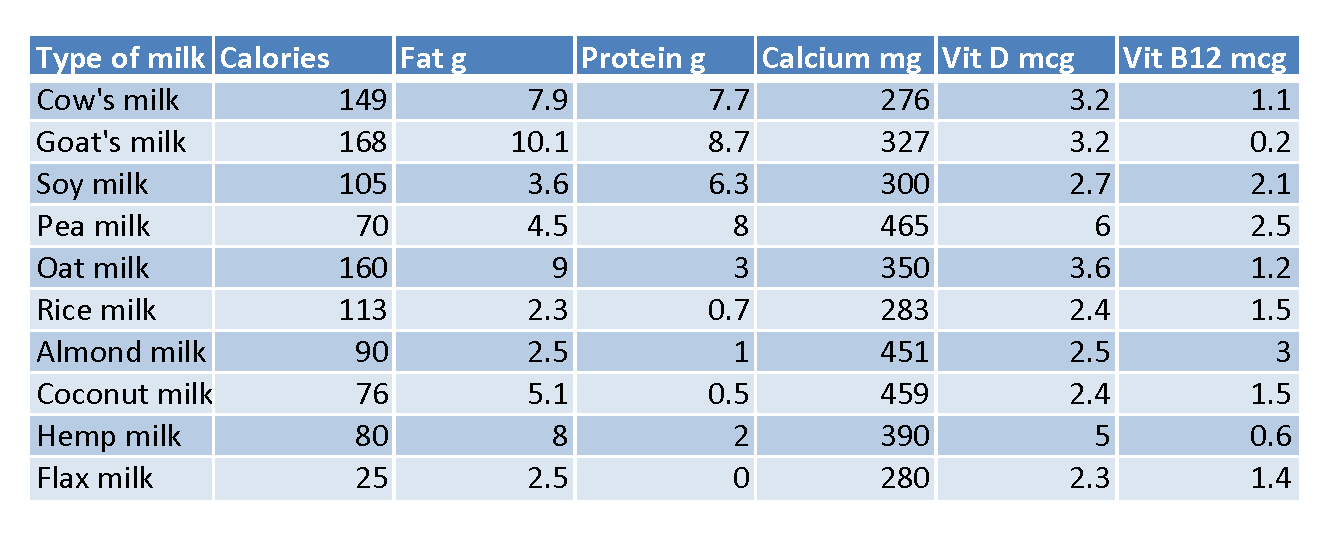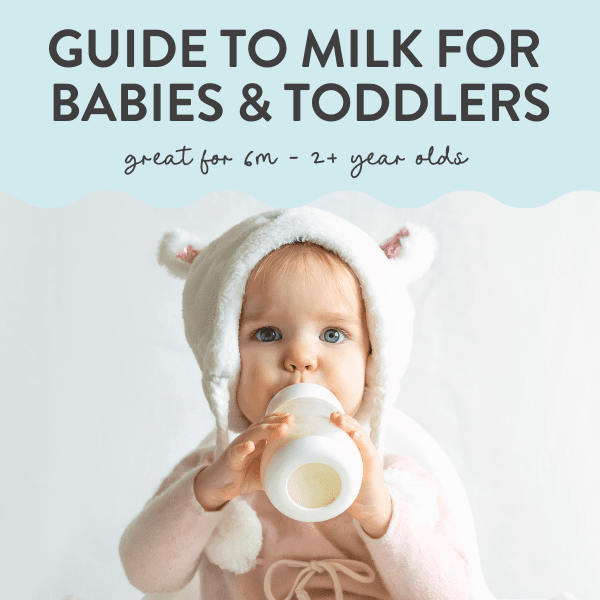In this Guide to Milk for Babies and Toddlers, you will find everything you need to know about milk for your child, including the benefits of milk, how and when to serve milk to your toddler, the deal with plant-based milks such as almond, soy, rice, oat, and coconut milk, the difference between organic and non-organic milk, common frequently asked questions, plus tips on how to serve milk to your baby and toddler, and so much more! Great for babies 6 months – 2+ years.
Medically reviewed and co-written by Jamie Johnson, Registered Dietitian Nutritionist (RDN), and Lauren Braaten, Pediatric Occupational Therapist (OT).
Milk for Toddlers
When it comes to hydration for babies, breastmilk or formula is all your baby needs until their first birthday. Once your baby is around 1 year, pediatricians suggest introducing whole cow’s milk.
Why wait until 1 year to introduce something besides breastmilk or formula as your baby’s primary source of calories and nutrition? It’s because babies cannot digest cow’s milk as completely or as easily as breastmilk or formula. For babies under 12 months, any kind of milk (including cow’s milk) doesn’t have the right amount of protein, fat, nutrients and minerals.
So how do you start introducing milk to your baby? Is dairy the best place to start? And what about all those plant-based milk alternatives? We’ll start by discussing the benefits of cow’s milk, as this is a common and easy transition for most babies.
If you are looking for easy and healthy milk recipes for your kid, then be sure to check out my Easy Mango Milk, the best Strawberry Milk, this homemade Chocolate Milk, Blueberry Milk, healthy Almond Milk, or this delicious Vanilla Milk. You can also find more recipes and information in my best-selling cookbook Little Foodies: Recipes for Babies and Toddlers with Taste.
Benefits of Cow’s Milk for Children
Cow’s milk is a versatile drink to include as part of a balanced nutrition plan for your child. Cow’s milk provides a good source of carbohydrates for energy throughout the day. Studies have shown that cow’s milk and dairy products are associated with reduced risks for childhood obesity, type 2 diabetes, and cardiovascular disease.
- Cow’s milk is full of calcium – which helps build strong teeth and bones. Most cow’s milk in the US is fortified with vitamin D, which is also essential for healthy bones and helps the body absorb calcium.
- Cow’s milk is also a good source of protein – so you can rest easy if your baby or toddler has a texture issue with meat, which is common, but drinks all of her milk, she’s at least getting in some protein.

Frequently Asked Questions
Yes, cow’s milk is a common allergen. Monitor your baby for any signs of an allergy and speak with your pediatrician if you suspect an allergy. Signs of a cow’s milk allergy include wheezing, trouble breathing, coughing, vomiting, diarrhea, itchy, watery or swollen eyes, etc. A child may have an intolerance to milk, which is different than an allergy, and may cause symptoms like loose stools, blood in stool, or irritability.
Yes, too much milk consumption or a milk protein allergy can cause constipation in some babies.
The American Academy of Pediatrics recommends waiting to introduce cow’s milk as a drink to most babies until one year of age, however, it can be introduced in cooking or baked goods before that.
Cow’s milk can be hard to digest and your baby’s digestive system is not well equipped to digest it until 12 months. It’s also high in protein and minerals that are hard for babies’ immature kidneys to process. It can irritate the lining of the stomach and intestines, which can cause iron-deficiency anemia in some babies.
Babies and toddlers need the nutrients found in milk, not the actual milk itself. Cow’s milk is an easy way for them to meet their calcium and protein needs but there are plenty of other foods that they can eat to also meet these needs.
How to Serve Milk for Ages 6 months – 2+ Years
It’s important to wait until your baby is 12 months to introduce cow’s milk as a beverage (unless otherwise directed by your pediatrician). That being said, babies under 1 year can have cow’s milk products.
Ages 6 monthes – 1 year
When baby starts solids, usually around 6 months, they can have yogurt and cheese. Avoid cubes of cheese and instead serve shredded or melted cheese to minimize the risk of choking. Stick to plain yogurt without any added sugar. You can jazz it up by adding pureed fruit or soft fruit chunks for added flavor. For cheese and yogurt, stick to full fat. Cow’s milk is also fine to include in baked goods or other cooking methods, just not as a beverage.
Ages 1 – 2+ years
At one year, you can introduce milk as a beverage, ideally in an open cup or straw cup with meals or snacks. A sippy cup is ok, too, however serving milk in a bottle has been associated with cavities and may lead to overconsumption of milk, which can lead to iron deficiency anemia, and underconsumption of solid foods.
When to Introduce Milk to Baby
Baby can start having milk as a drink at 12 months old.
How to Introduce Milk to Baby
You can go cold turkey with replacing breast milk or formula with whole milk or you can gradually do it by mixing them together by slowly replacing more and more of the breast milk/formula in the bottle/cup with whole milk over the course of a few weeks. Note that it’s also recommended to wean from a bottle by 12-18 months, which can also be a big transition. All of these changes for your baby at once can be too much so do whatever is best for your family.
How much milk should my baby or toddler have a day?
Baby
Babies under 1 year should not have any milk unless it is in small amounts mixed into foods.
Toddler
The American Academy of Pediatrics recommends toddlers 1-2 years old have up to 2 servings of dairy products a day, or 16-24 ounces of milk.
Toddlers 2-5 years old can have up to 2.5 servings of dairy a day, or 16-20 ounces of milk.
Milk Feeding Tips for Toddlers
- Make small and slow changes to breast milk or formula as needed. Start by replacing 1-2 tablespoons of breastmilk or formula offered at one sitting with cow’s milk. Replace this same amount in all bottles or cups offered on day 1. Then on day 2, replace 3-4 tablespoons, on day 3, replace 5-6 tablespoons, and so on. Over a period of about a week, your toddler will be drinking their new milk!
- Cold milk from the fridge may be a change for toddlers that are used to the temperature of drinks from a bottle warmer. Try warming the milk as you would normally, then gradually decrease the length of time it’s warmed over a period of several days.
- Serve foods first and offer milk towards the end of meals or snacks if your toddler seems to fill up on just milk.
- Stick to drinking milk only at meals and snacks. Avoid letting your toddler walk around with a milk cup between these times, because this decreases appetite for foods.
Can you still give baby formula, breast milk, and coy’s milk?
Yes, it’s perfectly fine (and encouraged) to continue giving breast milk along with cow’s milk. If feeding baby formula, talk with your pediatrician to see what they recommend. Most babies will be ready to wean off formula, but some babies may need it longer than others.
What is the Best Milk for Toddlers?
According to the American Academy of Pediatrics, the best milk for toddlers 1-2 years old is whole cow’s milk, assuming they do not have an allergy or intolerance.
Organic vs. Conventional Milk
While both types of milk provide essential vitamins and minerals, conventional milk comes from cows that can be given antibiotics and synthetic growth hormones and are fed a diet treated with synthetic pesticides to ensure maximum milk production. Some of these substances can make their way into the cow’s milk, which can lead to trace amounts being consumed by the consumer. Some studies suggest elevated growth hormones in humans can increase cancer risk and influence growth and development in children, however more research is needed to determine any long-term effects.
Organic milk comes from cows that have not been given antibiotics or synthetic growth hormones and their feed is also organic, and therefore not treated with synthetic pesticides.
Nutritionally speaking, organic and conventional milk have very similar nutrition profiles, however, organic milk may be slightly higher in Omega 3 fatty acids due to the difference in feed. Organic cows usually have more access to grass to feed on, whereas conventional cows are typically fed a grain diet.
Organic milk also lasts much longer in the fridge than conventional milk due to the difference in how they are pasteurized. Though it is more expensive than conventional if you’re someone who tends not to finish all of the milk before it goes bad, or are concerned about consuming trace amounts of antibiotics, growth hormones or pesticide residue, organic may be the way to go.
Best Plant-Based Milk Alternatives
If your baby or toddler cannot tolerate cow’s milk or your family is vegan, plant-based milk alternatives are available. However, not all will be good options for your baby or toddler so please choose wisely. Regardless of the plant-based milk, choose one that has no added sugar and has been fortified with calcium and vitamin D.
Soy Milk
Fortified organic soymilk is the next best option to cow’s milk (assuming baby does not have a soy allergy) because its nutrition profile is the closest to cow’s milk.
Rice Milk
Rice milk is not a great choice for babies since it is low in protein and may be high in arsenic.
Almond Milk
Although it is high in vitamin E, it is not a great choice as a beverage due to it being low in essential fats and protein.
Hemp Milk
Hemp milk is higher in fat than many of the other plant-based milks, however, it is low in protein so it’s not the greatest option.
Coconut Milk
Coconut milk is low in protein, which does not make it ideal as a drink for kids. But it can still be used in cooking, smoothies, popsicles, etc.
Oat Milk
Fortified oat milk is another good option if your baby or toddler is allergic to soy or peas since it is higher in calories than other plant-based milks. It has less protein than soy, pea and cow’s milk but more than other plant-based milks.
Pea Milk
Fortified pea milk is a good option since it is high in protein and vitamin D. It does have less than half the amount of calories that cow’s milk does, so if baby has trouble gaining weight, you may want to consider another option.
Graph of Nutritional Content of Dairy and Plant-Based Milks

Other Cow’s Milk Alternatives
There are a ton of other milk alternatives that are less common in the US, including camel, sheep, and buffalo milk and macadamia milk. But toddler formula and goat milk might also be something you are considering.
Toddler Formula
This is usually recommended by your pediatrician if your toddler is not gaining enough weight or has a medical condition like a severe food allergy that inhibits her from consuming a regular diet. They tend to be loaded with added sugar and sodium and are not recommended or needed for most toddlers.
Goat Milk
Goat milk is high in calories, fat, and protein so it may be a good alternative to cow’s milk, however not if your child has a true cow milk protein allergy. They’ll likely be allergic to goat milk, too. You won’t likely find goat’s milk as easily as cow’s milk in a grocery store unless you’re at a health foods store or ordering it online.
What if my baby or toddler won’t drink milk?
If your baby or toddler won’t drink milk, do not fear. Try serving them yogurt or cheese to help meet their calcium requirements. Try to make sure they have a balanced diet that includes foods that have the nutrients milk provides- calcium, protein, vitamin D, healthy fats, vitamin A, and zinc. Minimize junk foods as they can displace healthy foods in the diet that provide these nutrients when they get full off of them.
Expert Tips for Serving Milk
- Serve milk with meals or snacks at the table.
- Limit your toddler’s milk intake to 16-24 oz. a day.
- Ideally, serve milk in an open cup or straw cup (or sippy cup until they get the hang of the others).
- Don’t stress if your child won’t drink milk. You can feed them yogurt, cheese, and milk alternatives in addition to other foods high in calcium.
- Try splitting up milk servings throughout the day rather than all at one sitting.
- Or if your toddler prefers milk at a certain meal, like breakfast, offer milk then, and make the rest of the dairy servings yogurt or cheese.


